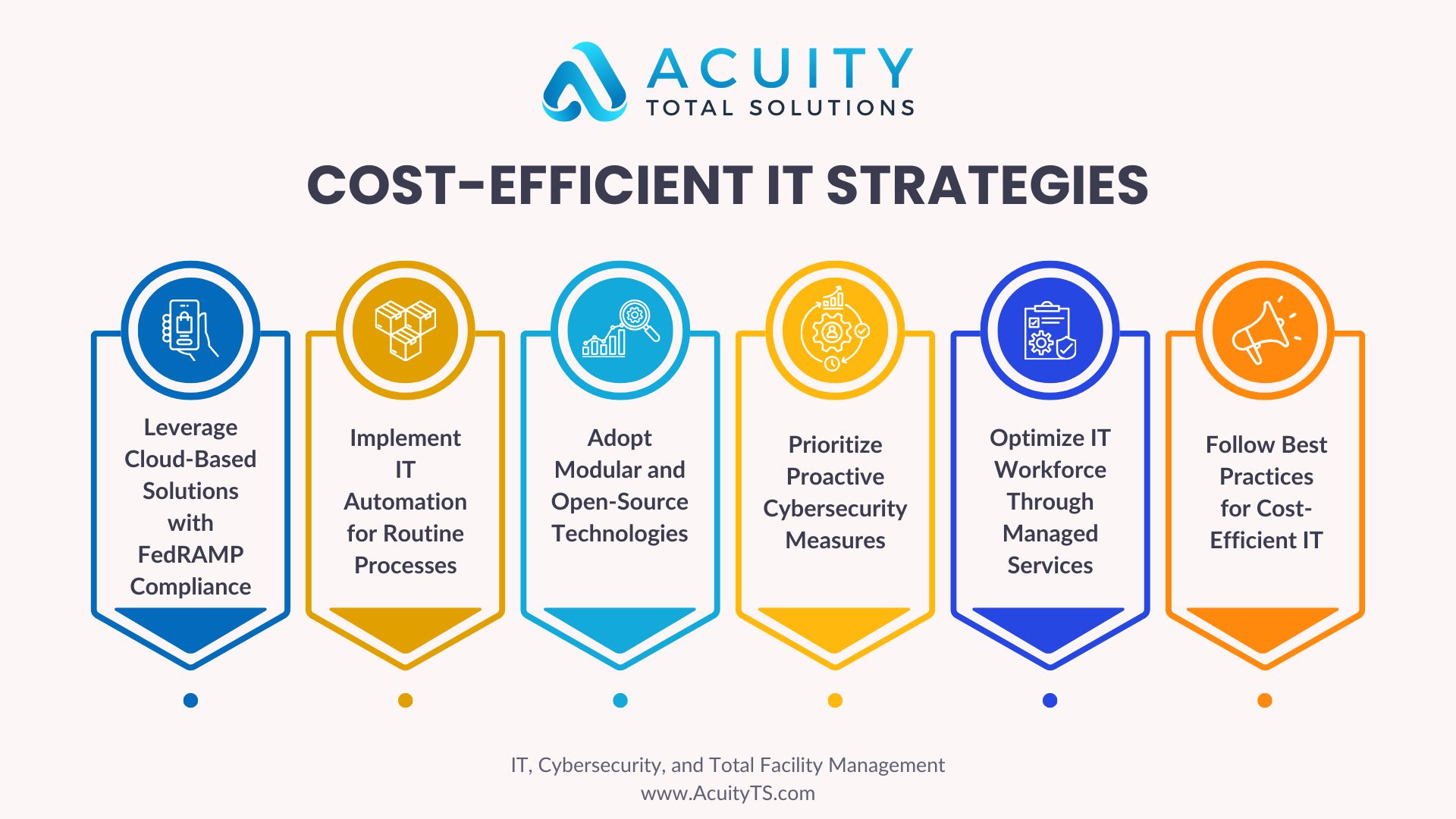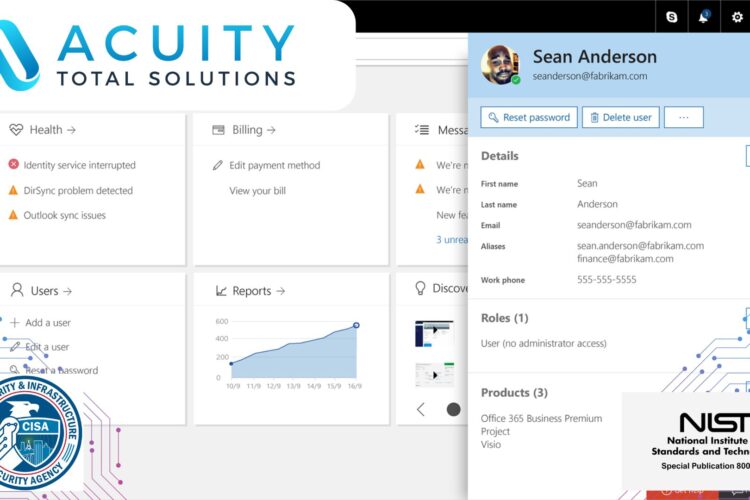
In 2025, federal agencies are facing intense pressure to cut costs while still worrying about keeping systems fast, secure, and compliant. To make matters worse, budgets are tight as cyberthreats grow and technology advances. This year, federal IT spending is expected to top $76 billion, but agencies are still being expected to do more with less. Fortunately, shrewd buyers can still slash costs without sacrificing security and performance. This article will share 5 proven strategies we use at Acuity Total Solutions, INC to help federal agencies and prime contractors save money while meeting mission-critical needs. We’ll also take a look at some common mistakes and how you can avoid them.
Common Challenges in IT Cost Management
It’s common for agencies to fall into the trap of choosing a cost-effective route that ends up costing more. Here are three mistakes that can hurt your overall performance.
Over-Reliance on Outdated Legacy Systems

Obviously, sticking with your current systems, even if they’re old, seems like a valid way to avoid new expenses. If it’s not broke, why fix it? The problem is that legacy systems are often costly to maintain. Frequent patches, outdated features, and limitations on growing demands can slow your work and expose you to various risks. For example, old systems often have extended downtimes, security risks, and higher long-term upkeep costs. And most outdated systems struggle to meet federal security rules like FISMA, putting agencies at risk of compliance penalties. Ultimately, performance suffers, and so does the mission and your colleagues.
Choosing the Cheapest Vendor Without Researching
Money’s the solution, so what’s the problem? It may be a cliche, but it’s true that you get what you pay for. Choosing the lowest bid for an IT provider can backfire in spectacular ways. A vendor may be cheaper, but do they have the experience or training to ensure your compliance needs? Will their solutions suffer regular failures, leading to repairs, delays, or even data breaches? Tech issues can rack up costs and disrupt operations exponentially. So a low price tag in of itself doesn’t guarantee value if the vendor can’t deliver.
Under-Investing in Scalable Infrastructure
Choosing short-term fixes may save money upfront, but quickly come back to haunt you. Solutions that aren’t designed to grow with the agency’s needs can lead to crashes when data or user demands spike. This disrupts your work and can lead to expensive upgrades. Non-scalable systems usually fail to keep up with modern government demand. That kills performance and budgets.
Proven Approaches to Cost-Effective IT Without Sacrificing Performance

So what’s the real solution? Let’s look at 5 strategies that can cut costs and keep your IT systems strong and protected.
- Leverage Cloud-Based Solutions with FedRAMP Compliance
Cloud platforms like AWS GovCloud or Microsoft Azure Government are secure, scalable, and cost-effective solutions that maintain compliance. Instead of buying expensive hardware, agencies pay only for what they use. This can significantly reduce costs and maintenance expenses. FedRAMP-authorized clouds have strict federal security standards, so it keeps you compliant without extra effort. Unlike slow and clunky legacy systems, cloud platforms update automatically and scale easily. They can maintain high performance, even during heavy workloads.
Our team guides agencies onto the cloud by planning and managing migrations, facilitating hybrid and multi-cloud strategies, implementing best-practices, and providing ongoing maintenance and training.
- Implement IT Automation for Routine Processes
While we all hear that automation is a powerful way to save time and money, many people don’t know how to integrate meaningful automation into their workflows. We employ industry tools to handle repetitive tasks like software updates, monitoring, or compliance checks. These tools reduce the need for manual work, thus reducing labor costs. Automation also reduces human error, keeping systems reliable. For example, by using automated security scans, we can catch issues much faster than manual checks. This protects your productivity and compliance while simultaneously limiting labor hours.
Of course, we have people available 24/7 in cases of emergency, but limiting manual processes saves staff time, keeps performance steady, and saves budget dollars.
- Adopt Modular and Open-Source Technologies
Open-source software has come a long way. There are some great tools available depending on the application. When a quality open-source tool looks like a good solution, it can provide big savings over expensive proprietary software. In addition, modular designs can sometimes allow you to upgrade just one part of a system instead of replacing everything. When appropriate, this approach can save budget dollars and keep your systems flexible for future needs. Unlike rigid, vendor-locked systems, open-source and modular solutions avoid high licensing fees while maintaining the ability adapt to change. Whenever possible, our experts choose and customize quality open-source solutions that meet federal requirements and keep costs low.
- Prioritize Proactive Cybersecurity Measures
Putting off cybersecurity protection because you’ve never been attacked is like leaving your keys in car because it’s never been stolen. In our day and age, every agency has to have a cybersecurity solution of some kind. But good cybersecurity doesn’t have to break the bank either. Live monitoring solutions have become more common, and competition is providing reasonable pricing for excellent services.
Automated monitoring systems catch and quarantine threats in real-time, often before they cause any harm. These proactive measures stop attacks early and avoid costly downtime or data breaches. Simply waiting to fix security problems after they happen is expensive and risky. Modern proactive tools keep systems secure and compliant with federal rules like NIST 800-53.
Our team is constantly looking for new ways to increase the security and performance of IT systems with these cost-effective tools.
- Optimize IT Workforce Through Managed Services
Managed service providers (MSPs) like Acuity can handle routine IT tasks like maintenance and support. Again, we help you reduce the need to hire and train in-house staff, saving significant costs. We bring expertise in federal contracts, ensuring compliance and performance. And unlike cheap vendors who cut corners, we deliver reliable solutions tailored to your agency’s needs. We keep systems running smoothly 24/7, freeing up your budget for mission priorities. We’ve helped many clients streamline operations with our managed services, boosting efficiency without sacrificing quality.
Best Practices for Implementing Cost-Efficient IT Solutions
To get the most out of these strategies, you’ll need to pick the best practices that work best for you. First, assess your agency’s needs carefully. By matching the right solutions to your mission and compliance requirements, you can avoid overspending. Second, prioritize interoperability. New systems should work with existing ones to prevent costly reconfigurations. Third, use data analytics to spot inefficiencies. Performance metrics will help you use your resources wisely, keeping costs down whenever possible. Fourth, involve stakeholders early. Get input from end-users to ensure the solutions fit real-world needs. Finally, always build with compliance in mind. Meeting standards like FedRAMP or NIST avoids penalties and repairs.
Conclusion
Federal agencies can control IT costs without losing performance. By leveraging cloud solutions, automation, open-source tools, proactive cybersecurity, and managed services, you can save money and keep systems reliable. Avoid mistakes like sticking with legacy systems, choosing cheap vendors, or overlooking scalability. The proven strategies discussed here can deliver results for agencies and contractors with tight budgets. Are you ready to transform your IT operations? Contact us today for a consultation on cost-efficient, high-performance IT solutions tailored for federal agencies. Let’s make your budget work smarter, not harder.


